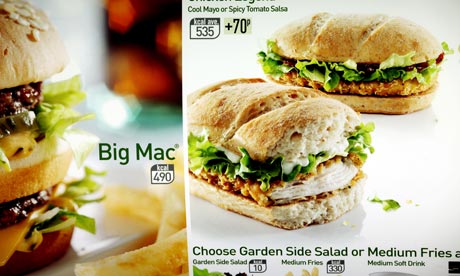
When he walked into the Cannon Street branch of McDonald's on Monday lunchtime, Fraser Reid was not overly concerned to see the calorific value of his Quarter Pounder emblazoned on the menu board in front of him.
"Four hundred and ninety? That's about a quarter of my daily intake. And I'm having it without cheese, so that'll be less," he mused. The 54-year-old was not prepared, however, to be ambushed by a medium chocolate milkshake (calories: 415). "I've just blown it," he laughed sheepishly. "This is my last chocolate shake."
His is unlikely to be the only vow of abstinence made at a McDonald's checkout this week as the company introduces calorie counts to menus in all 1,200 of its UK branches. As part of the government's "responsibility deal" on public health – a series of voluntary pledges aimed at involving the food industry in the fight against health problems such as obesity – McDonald's will feature the energy content of its burgers, wraps and even condiments on menus from Wednesday . The Department of Health advises a daily calorie intake of 1,940 calories per day for women and 2,550 for men.
At Cannon Street, central London, where the effort was rolled out on Monday before being extended to the rest of the country, a full list ranged from a bottle of mineral water (calories: 0) to a formidable 20-piece ShareBox of Chicken McNuggets (835). A Hash Brown clocked in at 130; a Belgian Bliss Brownie three times as many. Most customers welcomed the initiative – even if it did present them with a greater quandary at the till than they were expecting. Reid, who works in systems development for the banking industry, said it brought "clarity" to his lunchtime choices: "It's good to see how many calories I'm having." But he added: "I think that people know that McDonald's is what it is ... I don't think it'll make people walk away."
He was perhaps right in surmising that, despite having the truth laid bare for them at the point of purchase, most customers would end up ordering exactly what they had fancied when they came in. According to research carried out by the company itself among 2,000 of its customers, fewer than one in five – 17% – said that calorie information would make them think more about what they were eating.
At Cannon Street, Lola Aladeshelu agreed. While the scheme was a good one, she said, and food labelling was important, she and her fellow customers knew what they wanted and what they were getting – in her case, a Filet-o-Fish meal, which she estimated came to around 800 calories (a Filet-o-Fish alone would have been 350, medium fries a further 330). "The majority of McDonald's customers know it's junk food and people who come here to eat do so because they like the food," said Aladeshelu, who said she only paid a rare visit to McDonald's for a junk food "treat". She added that, around the Cannon Street neighbourhood, many other food outlets were offering healthier fare: "So food conscious people probably won't come."
Customers queued to buy Big Macs (490 calories), Banana Milkshakes (425) and Barbecue Dips (50), that certainly appeared to be the case. But Leanne Morris, a 21-year-old intern, was determined to buck the trend and "be healthy". Scanning the possibilities offered by the Deli Choice sandwiches on the menu board she complained that the figures on the board were too small to read ("and I'm wearing glasses!"). And, on being told that a crispy chicken and bacon sandwich clocked in at 635 calories, with a wrap of the same flavour clocking in at 495, she abandoned that plan in favour of her usual dish of plainer chicken.
The Department of Health believes nudging people towards healthier food with the use of clearer labelling could help tackle obesity. Along with McDonald's, chains such as KFC, Burger King and Pizza Hut have signed up for the labelling pledge and the department hopes more than 5,000 high-street food outlets will document calories by the end of this year.
Andrew Lansley, the health secretary, said on Monday the policy would help consumers "spot those hidden calories in their favourite foods and keep an eye on their waistlines".
Many, however, are sceptical of how effective calorie labelling will be. Research carried out this year in New York, where calorie labelling has been mandatory in fast food restaurant chains since 2007, concluded that only a minority of people were put off the more fattening options.
Dr Paul Gately, a professor of exercise and obesity at Leeds Metropolitan University and adviser to McDonald's, said: "One can't deny the positive impact giving consumers choice and giving them information can have. It's a no-brainer to provide people with information to make informed choices." But there was no data to show it could translate into a big impact on health, he said: "These sorts of nudge methods won't tackle real obesity."
On Monday lunchtime, one man knew he was being nudged towards the Grilled Chicken & Bacon salad (calories: 325) or the Garden Side Salad (10).
Herky Dialdas said he thought the scheme was "a good thing" and admitted "it's something I should be looking at more".
Standing beside the new menu, he reflected: "I should go for a salad rather than a sandwich." Minutes later, he scurried from the counter with a grin. What did he choose? "A Big Mac and chips."

